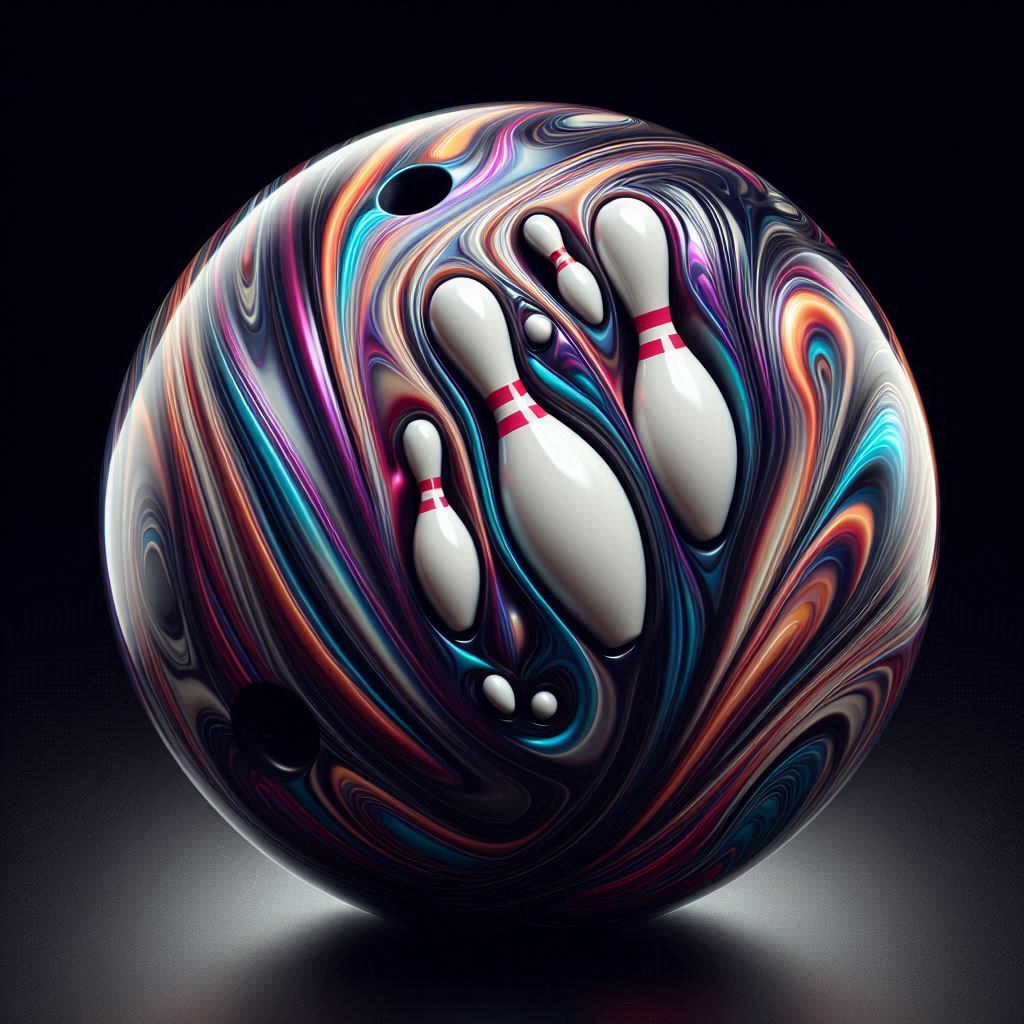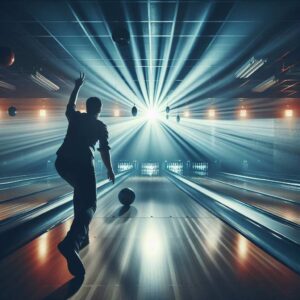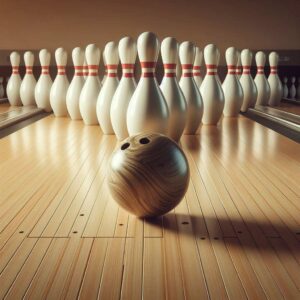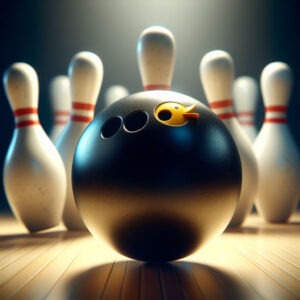Are you a passionate bowler looking to take your game to the next level? If so, investing in a high-performance reactive bowling ball could be the key to unlocking your full potential on the lanes.
Reactive resin balls are engineered to provide increased backend motion and a more aggressive hook potential, enabling you to generate more revs and create a powerful angular entry into the pocket.
Unlike traditional bowling balls, reactive balls feature a specialized coverstock material that interacts differently with the lane oil, allowing for enhanced traction in the oil and a more dramatic backend movement.
This trait makes reactive balls particularly beneficial for bowlers with mid-rev to high-rev rates, as they can maximize the ball’s hooking potential and score more consistently.
In this comprehensive guide, we’ll dive into the world of reactive bowling balls, exploring what factors to consider when making a purchase, reviewing the top 10 models for 2024, and sharing valuable insights on caring for and maximizing the performance of your reactive ball.
What to Look for When Buying a Reactive Ball:
When shopping for a reactive bowling ball, it’s crucial to understand the various factors that contribute to its performance and suitability for your playing style. Here are some key elements to consider:
Coverstock Material:
Reactive balls are available in three primary coverstock types: solid, hybrid, and pearl reactive. Each material offers unique characteristics:
-
- Solid Reactive: Durable and aggressive, solid reactive coverstocks provide maximum traction and hooking potential, ideal for heavier oil conditions.
- Hybrid Reactive: Combining the benefits of solid and pearl reactive materials, hybrids offer a balanced blend of traction and backend motion.
- Pearl Reactive: Known for their skid-flip motion, pearl reactive coverstocks are smoother in the oil, making them ideal for medium to drier lane conditions.
Core Design:
The core of a bowling ball plays a crucial role in determining its overall motion characteristics. Symmetric cores promote a more predictable and controlled motion, while asymmetric cores create more dynamic and angular backend reactions.
Differential and Intermediate Differential Numbers:
These numerical values indicate the ball’s potential for hook and backend motion. Higher differential numbers generally translate to increased flare potential, while intermediate differential numbers influence the ball’s midlane motion and track flare.
Hook Potential and Flare Potential:
Consider the ball’s hooking and flare potential to match your rev rate and desired ball motion. Higher hook potential suits bowlers with higher rev rates, while lower hook potential may be better for straighter players.
Intended Lane Condition:
Reactive balls are designed to perform optimally on specific lane conditions. Some balls excel on lighter oil patterns, while others thrive on heavier oil volumes. Match the ball’s intended lane condition to the patterns you typically encounter.
Budget Considerations:
Reactive bowling balls can range in price from around $100 to over $200. Determine your budget and prioritize the features most important to your game.
The 10 Best Reactive Bowling Balls of 2024:
Storm Phaze 4
-
- Overview & Unique Selling Points: The Storm Phaze 4 is a premium reactive ball designed for superior backend motion and punch-through power on heavier oil patterns. Its cutting-edge Velocity Pearl Reactive coverstock and asymmetric core create a potent combination for high-rev bowlers seeking maximum hook potential.
- Performance Analysis: The Velocity Pearl Reactive coverstock provides exceptional traction in the oil, allowing the Phaze 4 to maintain its energy through the midlane. The asymmetric core dynamics promote an aggressive, angular backend reaction, enabling the ball to tear through the pins with authority.
- Best For: The Phaze 4 is an excellent choice for high-rev players who frequently encounter heavy oil patterns and demand maximum hooking potential from their bowling balls.
- Specs: Coverstock – Velocity Pearl Reactive, Core – Asymmetric, RG – 2.49, Differential – 0.053
- Pros: Exceptional hooking potential, powerful punch-through on heavy oil, suitable for high-rev players.
- Cons: May be too aggressive for some bowlers or drier lane conditions, premium price point.
- Price: $229.99
Motiv Trident Remix
-
- Overview & Unique Selling Points: The Motiv Trident Remix is a versatile reactive ball that combines a durable Octane Nuclear Pearl coverstock with a dynamic asymmetric core. This combination delivers a potent blend of midlane control and backend hooking motion, making it a versatile option for various lane conditions.
- Performance Analysis: The Octane Nuclear Pearl coverstock provides optimal traction and responsiveness, while the asymmetric core promotes a strong backend transition and impressive hitting power. The Trident Remix excels at creating an angular entry into the pocket, maximizing pin carry.
- Best For: The Trident Remix is an excellent choice for bowlers with mid-to-high rev rates who need a ball that can handle a range of lane conditions, from medium to heavy oil patterns.
- Specs: Coverstock – Octane Nuclear Pearl, Core – Asymmetric, RG – 2.54, Differential – 0.047
- Pros: Versatile performance on various lane conditions, powerful backend motion, suitable for mid-to-high rev players.
- Cons: May not be the best option for extremely dry or heavy oil conditions, premium price point.
How to Care for Reactive Balls:
Proper care and maintenance are essential to ensuring your reactive bowling ball performs at its best and maintains its longevity. Here are some crucial tips for caring for your reactive ball:
- Wipe the Ball Surface After Use: After each bowling session, it’s vital to thoroughly wipe down the ball’s surface with a clean, dry microfiber cloth or towel. This helps remove any excess oil, dirt, or debris that can accumulate and potentially impact the ball’s reaction on the lanes.
- Use Ball Cleaner Solutions: Periodically, use a specialized ball cleaner solution to deep-clean your reactive ball. These solutions help remove built-up oil and grime, restoring the ball’s original surface texture and promoting optimal performance.
- Resurfacing at a Pro Shop: Over time, reactive balls can develop scratches, dents, or an uneven surface texture, affecting their performance. Regularly resurfacing your ball at a professional pro shop can help restore its factory-finish and extend its lifespan.
- Proper Storage: Always store your reactive bowling ball in a cool, dry place, away from direct sunlight or extreme temperatures. Avoid leaving the ball in your car or trunk, as temperature fluctuations can damage the coverstock material.
When Should You Change or Rotate Bowling Balls?
Even with proper care, reactive bowling balls will eventually show signs of wear and may require replacement or rotation. Here are some indicators that it’s time to consider changing or rotating your reactive ball:
- Signs of Wear or Dull Reaction: If your ball isn’t hooking or reacting as aggressively as it once did, or if you notice visible signs of wear on the coverstock, it may be time for a new ball. A dull or inconsistent reaction can negatively impact your scoring potential.
- Lane Oil Pattern Changes: When your local bowling center adjusts its lane oil patterns, your current reactive ball may not perform optimally on the new conditions. Rotating to a ball better suited for the new oil volumes or patterns can help maintain your scoring consistency.
- Bowler’s Rev Rate Changes: As you continue to develop your skills and technique, your rev rate may increase or decrease over time. If your reactive ball no longer matches your current rev rate, it’s advisable to switch to a ball better suited for your updated playing style.
Tips for Getting Maximum Performance from Reactive Balls:
To truly unlock the full potential of your reactive bowling ball and maximize its performance, consider the following tips:
- Proper Hand Position and Release: Maintaining a consistent, well-executed release is crucial for generating optimal revs and maximizing your reactive ball’s hooking potential. Work on keeping a relaxed, yet firm grip, and focus on a smooth, straight release.
- Adjust Speed, Rev Rate, and Axis Tilt: Experiment with varying your ball speed, rev rate, and axis tilt (the angle at which the ball rolls off your hand) to fine-tune the ball’s motion and create the desired backend reaction. These adjustments can help you adapt to changing lane conditions.
- Focus on Footwork and Timing: Proper footwork and timing are essential components of an effective and consistent bowling approach. By maintaining a well-balanced, fluid stride and synchronizing your footwork with your arm swing, you’ll be able to generate more consistent revs and leverage the full potential of your reactive ball’s hooking capabilities. Practice drills that emphasize foot positioning, slide-step timing, and staying behind the ball can help ingrain these fundamental techniques.
- Experiment with Different Ball Layouts: The layout of a bowling ball, which refers to the positioning of the pin and weight blocks within the core, can significantly impact its motion characteristics. Working with a professional at your local pro shop, you can experiment with different layout combinations to fine-tune the ball’s reaction and tailor it to your specific playing style and preferences.
- Manage Ball Surface: The surface preparation of a reactive ball plays a crucial role in determining its overall performance. Using specialized tools like Abralon pads or professional resurfacing machines, you can adjust the ball’s surface roughness or texture to manipulate its response to friction. A smoother surface can enhance length and backend motion, while a rougher surface can provide more traction and an earlier hook.
- Analyze Ball Motion and Make Adjustments: Regularly observe and analyze your ball’s motion on the lanes, noting any inconsistencies or areas for improvement. Don’t hesitate to make adjustments to your speed, rev rate, axis tilt, or ball surface as needed to optimize the ball’s reaction and achieve your desired motion path.
Conclusion:
Choosing the right reactive bowling ball can be a game-changer for bowlers of all skill levels. By carefully considering factors such as coverstock material, core design, differential numbers, and intended lane conditions, you can select a ball that complements your playing style and maximizes your scoring potential.
Remember, a reactive ball is an investment in your bowling performance, and proper care and maintenance are crucial to ensuring its longevity and consistent performance. Follow the guidance outlined in this article, and you’ll be well on your way to unlocking the full potential of your reactive ball, leaving your opponents in awe of your devastating hooks and pin-shattering strikes.
Ultimately, the key to success with reactive bowling balls lies in understanding your individual needs as a bowler, staying committed to continuous improvement, and embracing the thrill of watching your ball violently transition and deliver that satisfying strike every time. Keep practicing, keep experimenting, and keep pushing the limits of your game with the power of reactive bowling balls.





